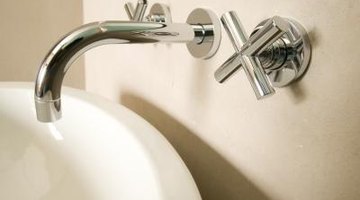What Should the Distance Between a Wall Faucet & the Top of the Sink Be?
A faucet that seemingly floats in the middle of the wall above a sink adds a decorative touch to your kitchen or bath. Unsightly water lines feeding the faucet are hidden behind the wall, giving your space a cleaner, appearance. Before you choose to install a wall faucet, take into account its length and distance from the sink. The wrong spacing could create a wet mess in your kitchen whenever you turn on the faucet.
Wall Faucets

Standard sinks use faucets mounted to the sink or counter. Wall-mounted faucets suspend the faucet and water valves on the wall above the sink. Structurally, a wall faucet looks like the plumbing for a shower. Unlike a shower, a wall-mounted faucet has the water valve handles on either side of the faucet instead of below it.
Where to Use Wall Faucets
The placement of wall-mounted faucets increases the amount of space in the sink. Consider one of these faucets for your kitchen sink if you use deep pots that you have difficulty filling in a traditional kitchen sink. Wall-mounted faucets also can be used for decorative vanity bowls as an alternative to a traditional sink style. If you choose to install a wall-mounted faucet over a bathroom vanity, consider placing the mirror higher than usual or moving the vanity mirror to another location in the room.
Height of Faucet
The distance between the top of the sink and the faucet on the wall must be high enough to allow for access to the sink but low enough so all the water from the faucet flows into the sink and not outside it. Hold the faucet against the wall and place your largest pot under it. The best height will be one where you can put the pot under the faucet without tilting the pot. Test the height where you want to install the faucet by pouring water from a glass where the end of the spout would be. If the water flows directly to the drain in the sink without hitting the sides of the sink, the site will work for the faucet.
Air Gap
The minimum height from the sink the faucet can be installed is called the air gap. Measure from the tip of the spout where the water comes out to the sink's overflow drain. This distance must be at least double the width of the opening of the faucet to create the proper air gap. For instance, if the opening of the faucet is 1/2-inch wide, you will need at least 1 inch of space between the spout and the overflow drain. If your sink does not have an overflow, use the top of the sink as the measurement. The air gap prevents the tip of the spout from becoming contaminated with water in the sink, which could affect the safety of water coming out of the faucet in the future.
References
- Designing Your Dream Home; Susan Lang
- Black & Decker Codes for Homeowners; Bruce Barker
- Black & Decker The Complete Guide to Bathrooms, Third Ed.; Chris Peterson
- Kitchen and Bath Design: A Guide to Planning Basics; Mary Fisher Knott
Photo Credits
- Jupiterimages/Photos.com/Getty Images
More Articles



